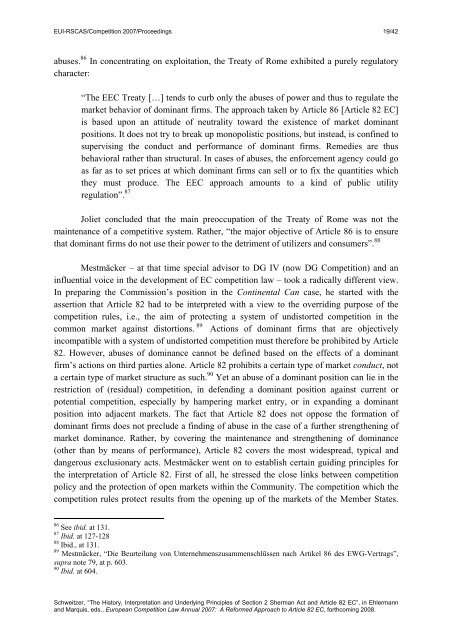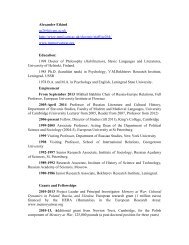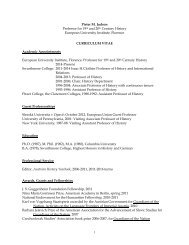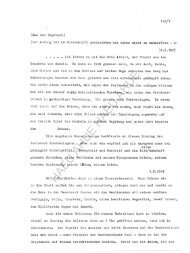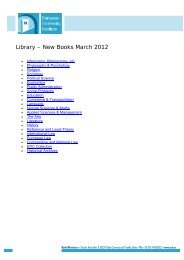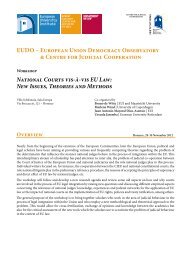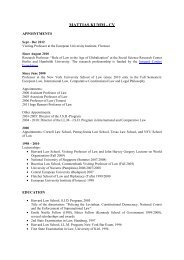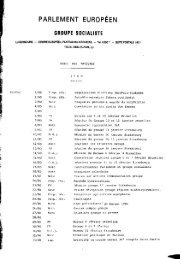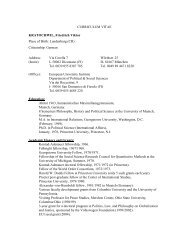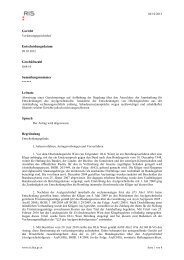The History, Interpretation and Underlying Principles of Section
The History, Interpretation and Underlying Principles of Section
The History, Interpretation and Underlying Principles of Section
You also want an ePaper? Increase the reach of your titles
YUMPU automatically turns print PDFs into web optimized ePapers that Google loves.
EUI-RSCAS/Competition 2007/Proceedings 19/42<br />
abuses. 86 In concentrating on exploitation, the Treaty <strong>of</strong> Rome exhibited a purely regulatory<br />
character:<br />
“<strong>The</strong> EEC Treaty […] tends to curb only the abuses <strong>of</strong> power <strong>and</strong> thus to regulate the<br />
market behavior <strong>of</strong> dominant firms. <strong>The</strong> approach taken by Article 86 [Article 82 EC]<br />
is based upon an attitude <strong>of</strong> neutrality toward the existence <strong>of</strong> market dominant<br />
positions. It does not try to break up monopolistic positions, but instead, is confined to<br />
supervising the conduct <strong>and</strong> performance <strong>of</strong> dominant firms. Remedies are thus<br />
behavioral rather than structural. In cases <strong>of</strong> abuses, the enforcement agency could go<br />
as far as to set prices at which dominant firms can sell or to fix the quantities which<br />
they must produce. <strong>The</strong> EEC approach amounts to a kind <strong>of</strong> public utility<br />
regulation”. 87<br />
Joliet concluded that the main preoccupation <strong>of</strong> the Treaty <strong>of</strong> Rome was not the<br />
maintenance <strong>of</strong> a competitive system. Rather, “the major objective <strong>of</strong> Article 86 is to ensure<br />
that dominant firms do not use their power to the detriment <strong>of</strong> utilizers <strong>and</strong> consumers”. 88<br />
Mestmäcker – at that time special advisor to DG IV (now DG Competition) <strong>and</strong> an<br />
influential voice in the development <strong>of</strong> EC competition law – took a radically different view.<br />
In preparing the Commission’s position in the Continental Can case, he started with the<br />
assertion that Article 82 had to be interpreted with a view to the overriding purpose <strong>of</strong> the<br />
competition rules, i.e., the aim <strong>of</strong> protecting a system <strong>of</strong> undistorted competition in the<br />
common market against distortions. 89 Actions <strong>of</strong> dominant firms that are objectively<br />
incompatible with a system <strong>of</strong> undistorted competition must therefore be prohibited by Article<br />
82. However, abuses <strong>of</strong> dominance cannot be defined based on the effects <strong>of</strong> a dominant<br />
firm’s actions on third parties alone. Article 82 prohibits a certain type <strong>of</strong> market conduct, not<br />
a certain type <strong>of</strong> market structure as such. 90 Yet an abuse <strong>of</strong> a dominant position can lie in the<br />
restriction <strong>of</strong> (residual) competition, in defending a dominant position against current or<br />
potential competition, especially by hampering market entry, or in exp<strong>and</strong>ing a dominant<br />
position into adjacent markets. <strong>The</strong> fact that Article 82 does not oppose the formation <strong>of</strong><br />
dominant firms does not preclude a finding <strong>of</strong> abuse in the case <strong>of</strong> a further strengthening <strong>of</strong><br />
market dominance. Rather, by covering the maintenance <strong>and</strong> strengthening <strong>of</strong> dominance<br />
(other than by means <strong>of</strong> performance), Article 82 covers the most widespread, typical <strong>and</strong><br />
dangerous exclusionary acts. Mestmäcker went on to establish certain guiding principles for<br />
the interpretation <strong>of</strong> Article 82. First <strong>of</strong> all, he stressed the close links between competition<br />
policy <strong>and</strong> the protection <strong>of</strong> open markets within the Community. <strong>The</strong> competition which the<br />
competition rules protect results from the opening up <strong>of</strong> the markets <strong>of</strong> the Member States.<br />
86 See ibid. at 131.<br />
87 Ibid. at 127-128<br />
88 Ibid., at 131.<br />
89 Mestmäcker, “Die Beurteilung von Unternehmenszusammenschlüssen nach Artikel 86 des EWG-Vertrags”,<br />
supra note 79, at p. 603.<br />
90 Ibid. at 604.<br />
Schweitzer, “<strong>The</strong> <strong>History</strong>, <strong>Interpretation</strong> <strong>and</strong> <strong>Underlying</strong> <strong>Principles</strong> <strong>of</strong> <strong>Section</strong> 2 Sherman Act <strong>and</strong> Article 82 EC”, in Ehlermann<br />
<strong>and</strong> Marquis, eds., European Competition Law Annual 2007: A Reformed Approach to Article 82 EC, forthcoming 2008.


